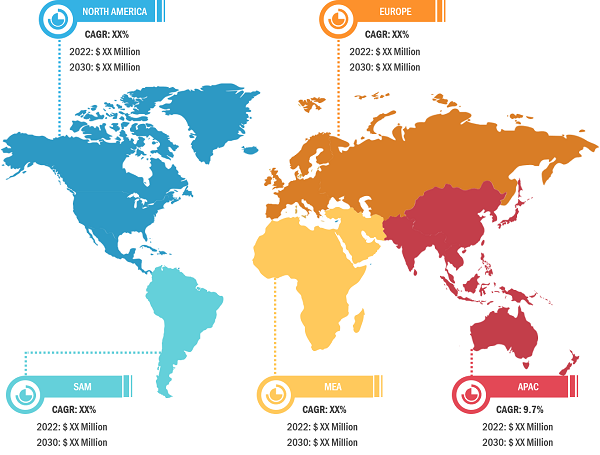Increasing Number of Data Centers Globally Boosts Rear Door Heat Exchanger Market Growth
According to our latest study on “Rear Door Heat Exchanger Market Forecast to 2030 – Market Size and Forecast (2020–2030), Global and Regional Share, Trends, and Growth Opportunity Analysis Report Coverage – by Type and End User,” the rear door heat exchanger market size was valued at US$ 647.75 million in 2022 and is expected to reach US$ 1,455.26 million by 2030. The rear door heat exchanger market is expected to record a CAGR of 10.6% from 2022 to 2030.
With the increased demand for immediate data transfer in offices, data is taking longer to reach its destination. Most organizations depend on large, outsourced data centers, usually located far from their place of business. There are various benefits offered by data centers. They provide redundant backup and a secure offsite location for all the business data. They provide rack space, a secure facility, and internet connectivity to keep the business running if something out of the ordinary happens to the business server. If the business is dependent on having access to the internet data and operations 24x7x365, a data center is critical and can ensure that the internet data is accessible. The products offered in the rear door heat exchanger market are essential components in modern data centers because they provide efficient and targeted cooling, improve energy efficiency, enhance reliability, and help data center operators manage the thermal challenges posed by increasingly powerful IT equipment and high-density rack configurations.
Rear Door Heat Exchanger Market – By Region, 2022 and 2030
Rear Door Heat Exchanger Market Size and Forecasts (2020 - 2030), Global and Regional Share, Trends, and Growth Opportunity Analysis Report Coverage: By Type (Active and Passive) and End User (Data Center, IT and Telecommunication, Semiconductor, Education, Government, and Others)
Rear Door Heat Exchanger Market Research Report by 2030
Download Free Sample
Source: The Insight Partners Analysis
According to the United States International Trade Commission (USITC):
- Spending on data center systems reached US$ 237 billion in 2021 worldwide.
- About 2% of the total energy is used by data centers in the US.
- There are almost 7,500 data centers worldwide.
- The largest concentration of data centers is in the US, with more than 300 locations
Moreover, pCloud is a data storage company, which operates in Switzerland; it provides cloud storage for the pricing of US$ 175 for premium 500 GB and US$ 350 for premium plus 2 TB. It offers features such as activity monitoring, shared folders, and set group/individual access levels. Other companies that offer data centers are Microsoft Azure, Zoolz, BigMIND, Polarbackup, PureStorage, AWS, Dell EMC, IBM, NetApp, Oracle, and Seagate Technology. Various companies are providing data center solutions for the storage, processing, and distribution of data. For instance, in June 2023, IT infrastructure and services firm NTT invested ~US$ 350 million and launched a new hyperscale data center campus in Chennai. It also announced the arrival and linkage of its subsea cable system MIST with the new DC campus. Also, in May 2023, Scala Data Centers announced the launch of 6 MW IT SGRUTB05 data center, which is the second-largest vertical data center in Latin America. Hence, with an increasing number of data centers, the demand in the rear door heat exchanger market is rising significantly, as the rear door heat exchangers are widely used for supporting high-density data centers.
There is a budding movement among major organizations with sophisticated IT infrastructure to modernize their systems owing to the increasing data storage and processing needs. For instance, according to 2022 article by Stack Infrastructure, In the upcoming year, 57.2% of businesses foresee an increase in average rack density, and in the following two years, 33.9% of businesses predict an increase of up to 24% and another 17.6% an increase of more than 25%. This has put enough potential in the rear door heat exchanger market for introduction of efficient solutions for such organizations. The industry will need to begin changing its cooling methods to be more adaptable and efficient as the demand for additional processing power inside data halls increases. With bigger deployments, rack densities will start to exceed the capabilities of flooded rooms or higher floor distributions, making this requirement even more crucial. This will drive the demand for products in the rear door heat exchanger market.
The rear door heat exchanger market is categorized on the basis of type, end user, and geography. Based on type, the rear door heat exchanger market is segmented into active and passive. By end user, the rear door heat exchanger market is segmented into data center, IT and telecommunication, semiconductor, education, government, and others. The rear door heat exchanger market, based on geography, is categorized into North America, Europe, Asia Pacific, the Middle East & Africa, and South America.
Coolcentric, Nortek Air Management, USystems Limited, COOLIT SYSTEMS, nVent Electric plc, Vertiv Group Corp, STULZ GMBH, Motivair Corporation, IBM, and Airedale are among the key players operating in the rear door heat exchanger market.
Contact Us
Phone: +1-646-491-9876
Email Id: sales@theinsightpartners.com